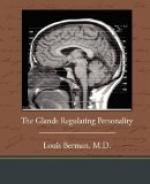Addison, speaking before the South London Medical Society in 1849, declared that in all of three afflicted individuals there was found a diseased condition of the suprarenal capsules, and that in spite of the consciousness “of the bias and prejudice inseparable from the hope or vanity of an original discovery ... he could not help entertaining a very strong impression that these hitherto mysterious organs—the suprarenal capsules—may be either directly or indirectly concerned in sanguification (the making of the blood): and that a diseased condition of them, functional or structural, may interfere with the proper elaboration of the body generally, or of the red particles more especially....” A modern, acquainted with after developments, would say that Addison was very hot upon the trail indeed. But withal, though he must have been well aware of John Hunter’s advice to Jenner on vaccination, “Don’t think, make some observations,” his training in the indirect reasoning and deductions of the clinician prevented him from going right on to a direct experimental test of his theories.
This Brown-Sequard proceeded to do. Removing the adrenal glands in several species of animals, he found, meant a terrible weakness in twenty-four to forty-eight hours, and death shortly after. If only one were removed, there was no change apparent in the normal animal, but death occurred rapidly upon removal of the other, even after a long interval. Furthermore, transfusion of blood from a normal into one deprived of its suprarenals prevented death for a long time, indicating that the suprarenals normally secreted something into the blood necessary to life.
The years 1855-1856 beheld two other important glands of internal secretion, the thyroid, the gland in the neck astride the windpipe, and the thymus, in the chest above the heart, make their debut.
The thymus was introduced by the great classic monograph of Friedleben on the “Physiology of the Thymus,” in which he mentioned the usual forgotten pioneers: Felix Plater, a Swiss physician, who in 1614 had found an enlarged thymus in an infant dying suddenly, and Restelli, an Italian, who interested himself in the effects of removal of the thymus more than ten years before. Friedleben believed that in the young without a thymus, there occurred a softening of the bones, and general physical and mental deterioration. He started the ball rolling for a number of researches.
Moritz Schiff, of Frankfort-on-the-Main, showed that excision of the thyroid gland in dogs is invariably fatal. A number of physicians in the first half of the century had reported certain remarkable symptoms associated with enlargement of the thyroid gland, as goitre. In 1825 the collected posthumous writings of Caleb Perry, an eminent physician of Bath, England, recorded eight cases, in which, together with enlargement of the gland, there developed enlargement and palpitation of the heart, a distinct protrusion of the eyes from their sockets and an appearance of agitation and distress. Schiff’s paper was the first to throw any light on the subject. But for some reason, probably the same as in Berthold’s forlorn experiments with the sex glands, the work of a person of no importance was ignored, or perhaps the more charitable view is that it was forgotten. Yet the tide of observation kept sweeping in relevant data.




